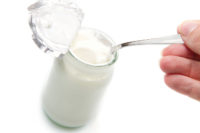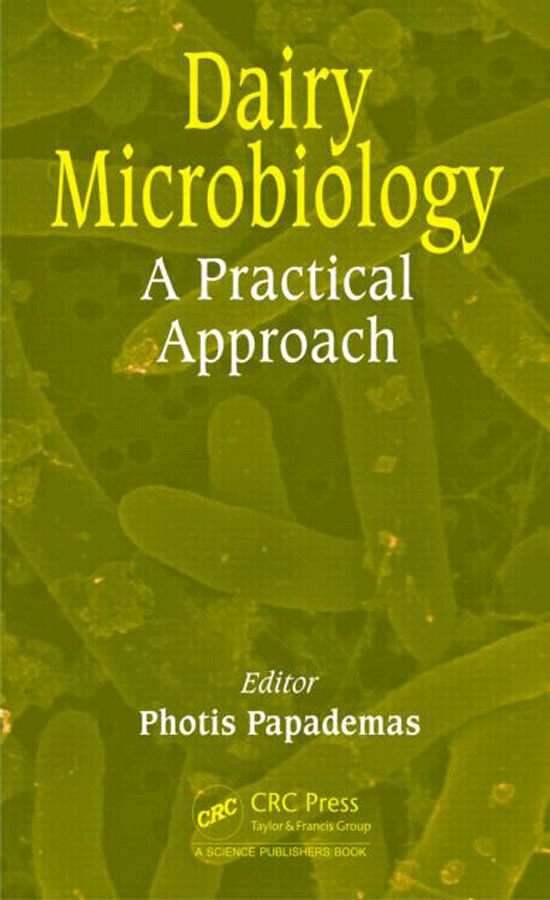A cultures and enzymes Q&A
Cultures help transform milk from a mild-flavored beverage into a smorgasbord of flavors, textures and products.

Dairy cultures are concentrated and frozen in pellet format.
Photo Courtesy of Chr. Hansen Inc.

Starter culture is being fermented in a test tube for testing.
Photo courtesy of Chr. Hansen Inc.

Cultures help to extend the life of milk. As cottage cheese, milk will last for more than 40 days; as aged Cheddar, for two years or more.
Photo courtesy of DuPont Nutrition & Health

North American consumers usually don’t like yogurt with a very acidic taste, says Gerald Dard of DSM Food Specialties. Processors need to be selective when choosing the right combination of culture strains to deliver low post-acidification.
Photo courtesy of DuPont Nutrition & Health

Cheese cultures from DuPont Nutrition & Health are for controlled acidification and for emphasizing and diversifying flavor profiles in soft, hard and smear cheeses.
Photo courtesy of DuPont Nutrition & Health





Cultured dairy is a dynamic segment these days, with everything from probiotic smoothies to artisanal cheeses, fermented milks and all manner of yogurts in the spotlight.
But while it’s the finished products that get the attention, it’s the backstage crew — dairy culture and enzyme systems — that deserve the credit. Indeed, the strains and systems coming online these days are “smarter” than ever. Working effectively with them requires formulation and processing “smarts” of your own. Industry experts update us about the whats, wheres and hows of today’s culture systems.
Dairy Foods: As if anyone needed reminding, let’s take a moment to acknowledge the key role that cultures play in the dairy industry.
Roy Riley, marketing director, cultures and enzymes, Chr. Hansen Inc., Milwaukee: Cultures help transform milk from a mild-flavored and healthy drink into a veritable smorgasbord of flavors and textures — from Greek yogurt to Asiago. And yet the greatest effect of all is their impact on the security of supply, as they help expand the short life of milk to over 40 days in the case of cottage cheese, 60 days for yogurt and two years for aged Cheddar.
Jeff Lambeseder, regional product manager, BioProtection, DuPont Nutrition & Health, Madison Wis.: Cheese-ripening cultures are essential in achieving the wonderful diversity of cheese types. They will contribute to flavor development (from sweet Cheddar to strong blue cheese), to the aspect of the cheese (blue cheese color, the velvety surface of Brie or the small round eyes in Swiss cheese), to the texture (from creamy soft to more or less crumbly).
Dairy Foods: So how do the culture strains available today differ from those we relied on just a decade ago? What issues are they addressing?
Lambeseder: A strong focus has been on functionality — selecting but also producing to achieve high functionality with high robustness in the application, as well. Some examples are increased speed of acidification with direct vat inoculation cultures, technology for phage robustness and also distinct flavors generated by flavor adjuncts or enhanced protective efficacy.
Riley: The biggest leap forward comes not just from the identification and development of new strains, but from the understanding of how to optimize the teamwork between strains that are fast versus slow, salt tolerant versus salt sensitive, et cetera.
Dairy Foods: “Teamwork between strains.” That’s a nice way of putting it. Give me a real-world example of how manufacturers can “leverage” this teamwork in their own cultured dairy products.
Lambeseder: We see this very often in the cheese industry. Many customers may use a very similar set of cultures for basic acidification of the cheese. By making use of flavor-adjunct cultures and different types of flavor-ripening enzymes, the ripened cheese can finish with a wide variety of different flavor and texture characteristics. This allows customers to differentiate and create their own signature cheese flavor, leading to value-added marketing.
So Penicillium camembertii is often used in association with Geotrichum candidum; they are part of the Brie type ABC. Our [products in combination] make a classic team for a fast-developing thin and white rind, which will keep a nice look along with cheese shelf life.
Riley: The emerging workhorse of the dairy industry is the mild mannered Streptococcus thermophilis. Long used in yogurt, it has also become prominent in American styles and cottage cheese types when used as a blend with Lactococcus lactis cultures. This mild-flavored culture has been an acidifying dynamo in cheese due to its high activity and phage robustness qualities.
The No. 1 priority and responsibility of these cultures is to acidify the milk in a dependable fashion and to do it in every vat or tank every day. As plants get bigger and older, the bacteriophage pressure increases and it has been the use of this culture in new and novel applications that establishes it as the star of the dairy culture world.
Dairy Foods: How big a concern is phage robustness in shaping one’s culture choice and deployment?
Riley: While flavor, texture and other functional qualities are critical for our customers to provide quality and premium products, the greatest needs that go hand-in-hand are robustness and consistency. These will indirectly impact cost-in-use — which often starts as the No. 1 priority but quickly drops in priority when cultures aren’t working properly. We are continually working to develop new strains and improve our knowledge of culture-blend dynamics to provide the state of the art in robustness and consistency. And these qualities are an absolute must as plants get bigger and the risk of culture failure increases.
Dairy Foods: What are the productivity implications of a phage attack?
Gerald Dard, dairy business unit leader, DSM Food Specialties: When a cheese plant gets a phage problem, the viruses attack the cultures and inhibit their activity. This impacts the cheesemaking process and reduces yield. Additionally, it takes time to identify where the phage is located in the processing line, and that can cause you to shut down production as you clean up your line entirely. So you can imagine how much that affects the productivity of the cheesemaker, for example.
Dairy Foods: Give me an idea of how you build phage robustness into culture strains.
Dard: Our aim is to work with multiple, very distinct rotations of a given culture to minimize phage sensitivity and maximize phage robustness. First you want to start with a culture that is very strong — the stronger the better. Then you can bring peace of mind to the cheesemaker by providing several rotations — several generations of the same kind of culture — such that if there is a phage “enemy” capable of destroying your initial culture, you have other rotations to replace it. These rotations are your “spare parts” that are available and work with the same reliability and consistency to produce the same quality product at the end of the line.
Dairy Foods: Other than phage robustness, what culture issues are cheese manufacturers facing?
Riley: The need for greater consistency in final cheese pH and moisture remains a critical target. The mega-cheese plants are pushing milk through faster and at increasingly higher solids to maximize plant throughput. The development of culture programs to satisfy not only plants using “normal” milk solids but those using higher milk solids has been an evolution.
Also moving up the priority list is the need for flavor development to be faster and more versatile. The desired aged-Cheddar flavor profile differs greatly among the Eastern, Midwestern and Western regions, for example, and these “signature flavors” can’t be met with the same culture and process.
Dairy Foods: That sounds like a real challenge: creating cheeses of regional character in an age of mass production. How can cultures help us reconcile these competing imperatives?
Dard: Because companies have to be fast in production and fast to market, cheeses don’t always get to age very long. And often, particularly in process cheese, there is a certain level of standardization of production. As a result, you may have a bland flavor in the end product.
So you’ll want to re-establish those distinctive flavors in a natural way — i.e. not using flavor ingredients, which, in a lot of cases is not authorized according to the standard of identity for the cheese. Or maybe you’ll want to introduce new flavors to bring in a little “goaty” or nutty flavor, or maybe a fruity flavor in one of the less-aged Cheddars that are being made.
The use of combinations of lactic cultures — both ripening and classical cheese cultures — allows you to generate and deliver a large spectrum of different flavors to modern cheese production. For example, as we produce two types of lactic cultures — one in North America and one type in Europe — we can produce flavors that are unique and familiar to each market.
Dairy Foods: How else might manufacturers use cultures to manipulate and improve cheese flavor?
Dard: We are seeing a trend toward higher quality. That, in turn, requires the use of different cheese cultures to provide these more distinctive cheese tastes, flavors and textures in the finished products. As always, it’s a combination of improving the cheese-make speed — accelerating the acidification through use of the right cultures — but also making sure that you preserve the right taste at the end of your processing chain. And you need to do that in a reliable, consistent and predictable way. That’s the name of the game.
In particular, we are working on reducing proteolysis in the cheesemaking process not only to extend shelf life, but also to preserve the overall good taste of the cheese. Until now, the industry was providing cultures for fast acidification only, which was positive, but it was at the expense of achieving the right taste and flavor in the end product. We’ve quite recently launched a range of cultures that addresses exactly that.
Riley: The growing need to produce quality cheese with decreasing salt levels creates the potential for off flavors such as bitterness, along with reduced mouthfeel and increased body breakdown. Our [proprietary] concept includes [a] cheese coagulant which greatly reduces the texture breakdown and potential development of peptides that are precursors to bitter flavor development. By combining this with specific flavor culture adjuncts, we can improve the overall flavor and texture of cheese with reduced salt levels.
Dairy Foods: Let’s move on to yogurt. What’s new in yogurt’s culture club?
Lambeseder: Taste is key today for yogurt producers. For example, cultures for dahi [a style of yogurt popular in South Asian countries like India and Pakistan] provide fast and robust acidification while offering the clean and short cut-curd that enables the consistent creation of an authentic dahi taste.
Dard: In North America and Asia, consumers usually don’t like yogurt with a very acidic taste. So you need to be very selective in choosing the right combination of culture strains to deliver low post-acidification — meaning that after fermentation, you don’t want these strains to generate further acid. This lets you keep the acid level extremely low to get the sensation of a very smooth and very mild yogurt.
Riley: The explosion of the Greek yogurt market has pushed the boundaries of melding cultures and process together. The preferred cultures provide the necessary texture and flavor — mild to medium — with minimal pH post-acidification during the concentrating process after fermentation.
Dairy Foods: It sounds as if by using low post-acidification strains, we might produce a milder — you could even call it “sweeter” — yogurt while using less sugar. Is that the case?
Dard: Yes, and you can even also consider using less protein in certain applications — which, as we see a big trend toward milk price increases, is also costly. This is very welcoming to manufacturers as a way to control the volatility of some of these core ingredients.
Furthermore, delivering the right texture is also key for yogurt producers. We get many requests from our customers saying they would like to offer thick, creamy yogurt textures but with a low or lower fat content. It is great to see that cultures make this possible.
Dairy Foods: It’s also welcoming as a way to improve a product’s label. How else might we leverage culture system functionality to scrub labels of ingredients consumers might be avoiding?
Riley:The use of cultures that provide EPS (exopolysacharide) and CPS (capsularpolysacharide) accomplishes virtually all of the benefits mentioned above. While EPS cultures are the mainstay in all yogurt and sour cream for texture development, they become especially critical for “all-natural” products that are unable to rely on various stabilizers to build texture and minimize wheying off during shelf life.
In cheese, the use of CPS cultures has provided many benefits including greater moisture, yield and robustness. Also of great importance is that these CPS cultures do not impact downstream whey handling.
Dard: Through combining the right strains, you can address the need for “naturalness” in the formulation of yogurt — to where you’re essentially using fruit prep, sugar, milk and a culture, period. You’re not adding any other ingredients.
The secret to this is in the “raw material,” which is ultimately the quality of your strains and the ability to combine them the right way to deliver this functionality. It’s about characterizing your strain very well — defining the “ID card” of each strain in your library — and then picking the right ones, assembling them and ending up with this attractive effect in the end product.
Dairy Foods: Clean labels are attractive to health-involved consumers. So, too, are probiotics. What’s the outlook?
Michael Bush, vice president of business development, Ganeden Biotech Inc., Cleveland: Probiotic research application and consumer acceptance are at an all-time high and growing significantly each year. The probiotic industry is expected to reach $32 billion by 2015, of which nearly $30 billion will be generated through the sale of functional foods and beverages. We’re seeing a tipping point here as more consumers become aware of natural ways to support digestive health and look for products to give them the support they desire without resorting to the use of pharmaceutical drugs.
Dairy Foods: How is the “evolution” of probiotic cultures keeping pace with this fervent consumer interest?
Bush: With the growing demand for probiotic-fortified foods and beverages comes the demand for more options. But options are limited with traditional dairy cultures. Ganeden Biotech offers a patented probiotic strain that has opened up completely new categories for probiotic foods and beverages.
Dairy Foods: What makes it different?
Bush: It’s unique because inside each cell is a hardened structure, or spore, which is similar to a seed. This spore serves as a natural protective shield against the heat and pressure of manufacturing and the acidic conditions of the stomach so that it arrives alive and then thrives in the gut — its intended target — to help support digestive and immune health. Other traditional probiotic bacteria, such as Lactobacillusand Bifidobacterium, are not able to form these protective spores, making them more vulnerable to manufacturing processes and stomach acid.
Dairy Foods: Several players in the frozen yogurt market are touting their products as probiotic rich — but I always wonder, “Are those little guys even still alive in there?” Can probiotics survive in the frozen medium?
Bush: We believe that the simplest solution to frozen formats is the use of shelf-stable probiotic cultures, as they are able to withstand the intense temperature shifts seen in the frozen yogurt production process, where traditional cultures tend to have large losses during freezing because of the formation of ice crystals inside of the cells.
Dairy Foods: So in the end, what’s your best advice for formulating and processing successfully with dairy cultures?
Lambeseder: It’s always helpful for our application specialists when customers are able to share some specifics for what type of flavor and texture characteristics they are targeting in the dairy product. Sharing as much information as possible about the components and process will enable application experts to pick culture systems most suitable for the desired result in the fermented dairy product.
Riley: The key to matching culture to process is in the details. The better the understanding of the flavor and texture target profiles and plant processing conditions, the greater the probability of finding the correct culture solution. Even then, plant process fine-tuning is often required to hit the targets dead center. It is this customer-vendor partnership that provides the best chance for success.
Looking for a reprint of this article?
From high-res PDFs to custom plaques, order your copy today!











